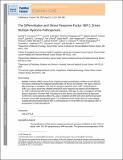The Differentiation and Stress Response Factor XBP-1 Drives Multiple Myeloma Pathogenesis

View/
Author
Carrasco, Daniel R.
Sukhdeo, Kumar
Protopopova, Marina
Enos, Miriam
Zheng, Mei
Mani, Mala
Ivanova, Elena V.
Tonon, Giovanni
Carrasco, Daniel E.
Note: Order does not necessarily reflect citation order of authors.
Published Version
https://doi.org/10.1016/j.ccr.2007.02.015Metadata
Show full item recordCitation
Carrasco, Daniel R., Kumar Sukhdeo, Marina Protopopova, Raktim Sinha, Miriam Enos, Daniel E. Carrasco, Mei Zheng, et al. 2007. The Differentiation and Stress Response Factor XBP-1 Drives Multiple Myeloma Pathogenesis. Cancer Cell 11(4): 349-360.Abstract
Multiple myeloma (MM) evolves from a highly prevalent premalignant condition termed MGUS. The factors underlying the malignant transformation of MGUS are unknown. We report a MGUS/MM phenotype in transgenic mice with Eμ-directed expression of the XBP-1 spliced isoform (XBP-1s), a factor governing unfolded protein/ER stress response and plasma-cell development. Eμ-XBP-1s elicited elevated serum Ig and skin alterations. With age, Eμ-xbp-1s transgenics develop features diagnostic of human MM, including bone lytic lesions and subendothelial Ig deposition. Furthermore, transcriptional profiles of Eμ-xbp-1s lymphoid and MM cells show aberrant expression of known human MM dysregulated genes. The similarities of this model with the human disease, coupled with documented frequent XBP-1s overexpression in human MM, serve to implicate XBP-1s dysregulation in MM pathogenesis.Other Sources
http://www.ncbi.nlm.nih.gov/pmc/articles/PMC1885943/pdf/Terms of Use
This article is made available under the terms and conditions applicable to Other Posted Material, as set forth at http://nrs.harvard.edu/urn-3:HUL.InstRepos:dash.current.terms-of-use#LAACitable link to this page
http://nrs.harvard.edu/urn-3:HUL.InstRepos:8160855
Collections
- HMS Scholarly Articles [17922]
Contact administrator regarding this item (to report mistakes or request changes)


